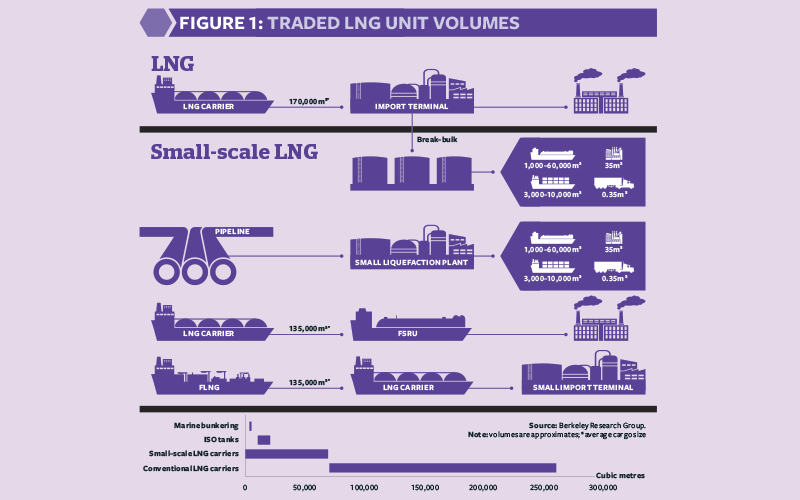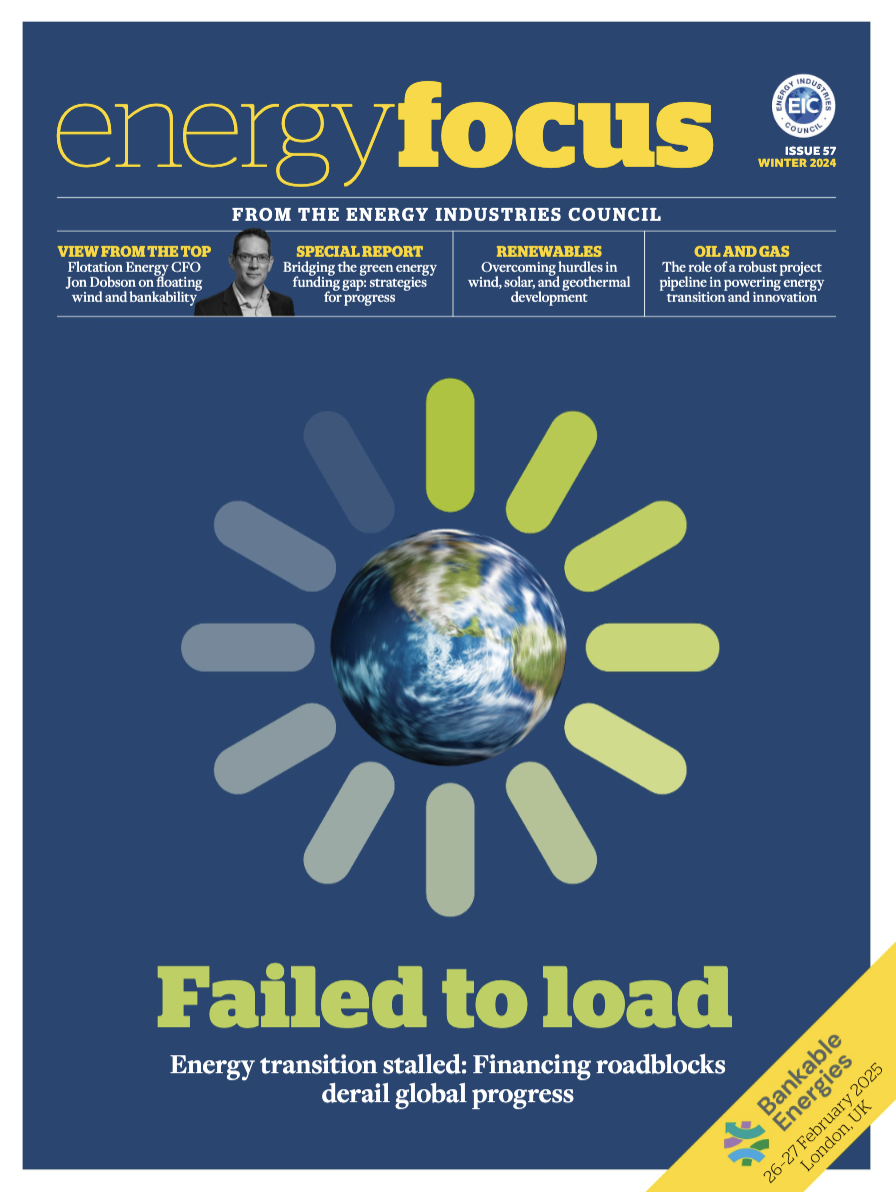The big potential of small-scale LNG
Joanna Martin Ziegenfuss at Berkeley Research Group gives a clear insight into the potential of small-scale LNG and the shape of things to come.

The global liquefied natural gas (LNG) market is progressively becoming more flexible and liquid. It is undergoing a structural change driven by the increase in LNG supply, contracts with shorter terms, greater destination flexibility and the growth of LNG spot trading.
Furthermore, the advent of the shale revolution and subsequent cheap natural gas in the US has spurred the growth in demand for small volumes of LNG as an alternative fuel to diesel and heavy fuel oil. Early adopters, motivated by the price and environmental advantages relative to oil, have backed LNG as a fuel in markets that range from transportation and high horsepower applications to remote small power generation. Technology innovations have also made it economically feasible for emerging economies to import small to medium volumes of LNG. Can this growth in the trade of small LNG parcels effectively contribute to increased liquidity in the LNG market?
What is small-scale LNG?
Small-scale LNG (SSLNG), loosely considered by the LNG industry as liquefaction and regasification terminals with a production capacity smaller than 1m tonnes per year, is a growing market enhancing the distribution downstream of LNG.
In terms of traded unit volumes, the SSLNG market ranges from parcels of 0.35m3 for LNG trucks to LNG ISO tanks of 35m3 for delivery to industry, to volumes ranging from ~1,000m3 to 60,000m3 for SSLNG carriers servicing the bunkering and coastal distribution markets to small conventional LNG carriers ranging from ~60,000m3 to 160,000m3 servicing floating regasification units (FSRUs) and floating liquefaction units (FLNGs).
This broad range of unit volumes and end-market buyers contrast with the large conventional LNG cargoes that range from ~135,000m3 to 260,000m3 and service only the LNG gas-to-power market (see Figure 1).

Although the current narrow spread between oil and gas prices has stifled the growth of SSLNG in the US, market developments in the rest of the world have continued to grow driven by resilient oil to gas price margins, technology innovations, as well as environmental and energy diversification policies.
Global growth markets
The LNG trucking markets in Europe and China have seen strong growth in recent years. The market in the EU has grown by approximately 300% since 2013, and is projected to reach 400,000 LNG trucks by 2030. The market in China has close to 250,000 LNG trucks on the road and is projected to grow to 700,000 in the next three years. The bunkering market in China is also well developed, with an estimated 19 bunkering pontoons and 23 LNG fuelled vessels in planning.
The current number of LNG fuelled ships is estimated at 100 vessels and expected to double in the next two to three years. This growth has led to the development of small-scale liquefaction facilities in China and the US, close to 60 LNG bunkering facilities worldwide and break-bulk facilities at LNG import terminals. The Gate LNG Import Terminal in Rotterdam, for example, has already made break-bulking and truck-loading adjustments to capture new commercial opportunities in the industrial, bunkering and trucking markets. Many new LNG import and export terminals under development are being designed to offer break-bulk services and truck loading capabilities that will further expand the downstream distribution of LNG.
Unlocking stranded assets
In the last four years, the LNG market has also witnessed a strong growth in floating storage FSRUs (from 10 to 24 since 2013) unleashing latent small to medium demand from emerging nations. While individually small volumes, the aggregate demand from FSRUs in 2017 is estimated at 83m tonnes per year based on nameplate capacity (International Gas Union World LNG 2017 Report), roughly equivalent to one tenth of current onshore regasification capacity. Small to medium LNG imports through FSRUs are projected to grow with another 11 vessels on-order targeting mostly emerging importers. Innovations in technology have also driven the development of FLNGs allowing the monetisation of stranded gas previously uneconomical to develop. There are a number of projects on the west coast of Africa (Cameroon, Equatorial Guinea and Mauritania) with anticipated liquefaction capacity in the range of 1–2m tonnes per year. Once in operation, those projects will be delivering LNG cargoes to the market in small to medium LNG carriers. These developments, in addition to increasing uptake of break-bulk services, have also driven the growth in recent years of small LNG carriers.
Future trading mix
The growth of SSLNG markets brings additional volumes, a broader diversity
of sellers, offtakers and cargo sizes to the trading mix, which will allow for supply and demand to be paired at smaller tranches. This could effectively impact price elasticity of demand in the global LNG market, as well as liquidity, once sufficient volumes are attained. The recent growth in FSRUs has already demonstrated how an aggregation of relatively small demand volumes managed to absorb some of the LNG surplus on the market in 2016, effectively impacting demand elasticity in the short-term.
However, it is too early to foresee how and when this influx of smaller cargoes will effectively impact LNG price and volatility. Effective LNG market liquidity will develop in regional pockets at trading hubs which can cater to anchor power markets as well as the growing small to medium markets and thereby allow the trade of a broader mix of cargo sizes between a diversified range of suppliers and buyers.
Market to watch: Indonesia - Indonesia has the potential and the ambition to become Asia's most important small-scale LNG player
SSLNG offers significant potential in Indonesia, an archipelagic country of over 18,000 islands, where demand, infrastructure and geography present significant challenges to the distribution of LNG. With isolated consumption centres and a limited national pipeline network outside Sumatra and Java, SSLNG is an attractive solution – especially in the eastern region of Indonesia where the high capital investment cost of constructing extensive gas transmission pipelines is not feasible given the relatively low gas demand.
SSLNG offers several key advantages that favour the growth of the industry in Indonesia. Firstly, it significantly reduces the time needed to get projects up and running, allowing investors more immediate and potentially attractive returns in the medium-term, while reducing uncertainty on project execution due to its plug-and-play nature. The industry is also scalable, meaning operators can easily alter capacity to serve fluctuations in demand. Finally, it offers location flexibility, so it can move to another area when it is no longer needed and can meet demand in areas that were previously unsuited to LNG as a fuel source, such as off-grid power generation on the remote islands of eastern Indonesia.
Indonesia received its first floating regasification unit in March 2016 from South Korean firm Gas Entec, which will supply 40m standard cubic feet of gas per day to a 200MW power plant in Bali. More recently, Singapore-based Pavilion Gas and Keppel Offshore & Marine signed a Heads of Agreement with PLN of Indonesia in September 2017 to explore SSLNG in remote areas of western Indonesia.
There are, however, several challenges facing Indonesia’s SSLNG plans, with the most prominent being transportation. Companies will either have to break-bulk cargoes, reducing economies of scale, or use containers which can be shipped by other transportation methods such as rail or road. Furthermore, SSLNG is expected to be more expensive on a MMBtu basis due to the increased operational complexities compared with a typical-sized plant, a factor further exacerbated by the remoteness of some of Indonesia’s islands.
More information: If you are interested in Indonesia’s SSLNG market, download the EIC Country Report: Indonesia at www.the-eic.com/Publications MarketIntelligenceReports.aspx
By Joanna Martin Ziegenfuss, Associate Director Energy, Berkely Research Group
Disclaimer: the opinions expressed herein are those of the individual author, and do not represent the opinions of Berkeley Research Group, LLC or any of its other employees or affiliates.






Follow us
Advertise
Free e-Newsletter